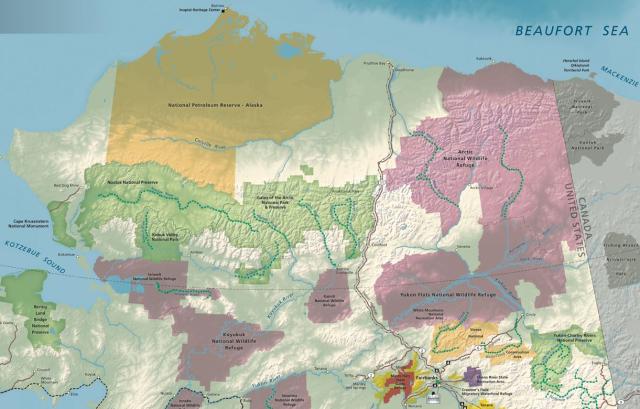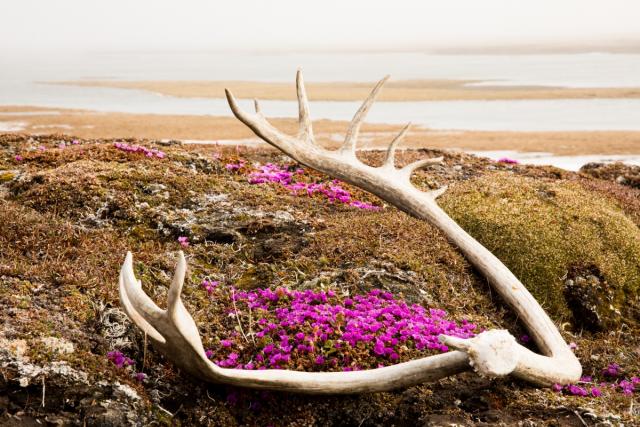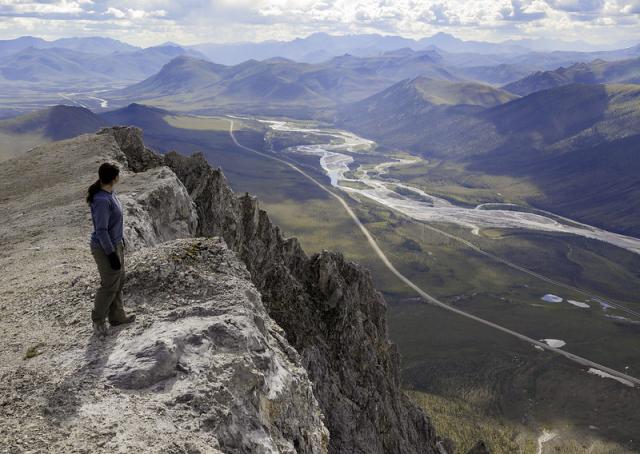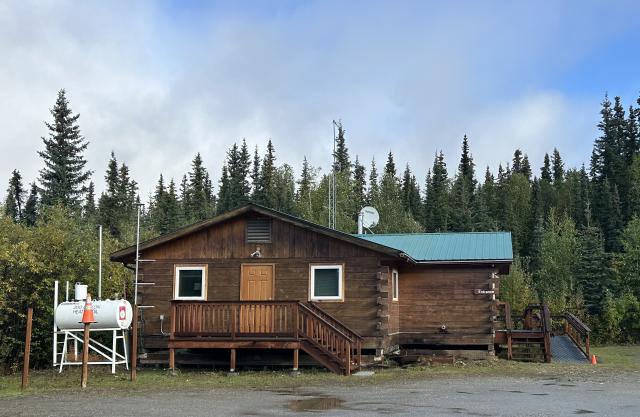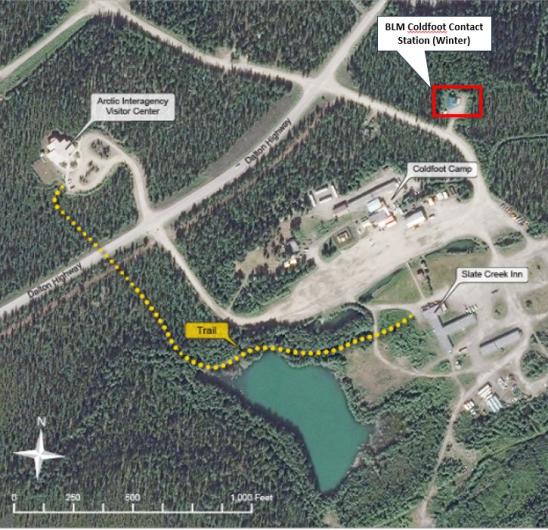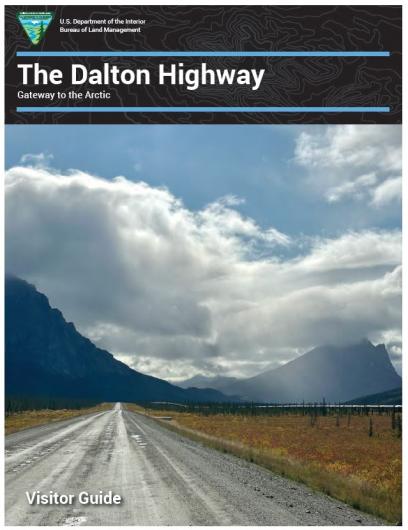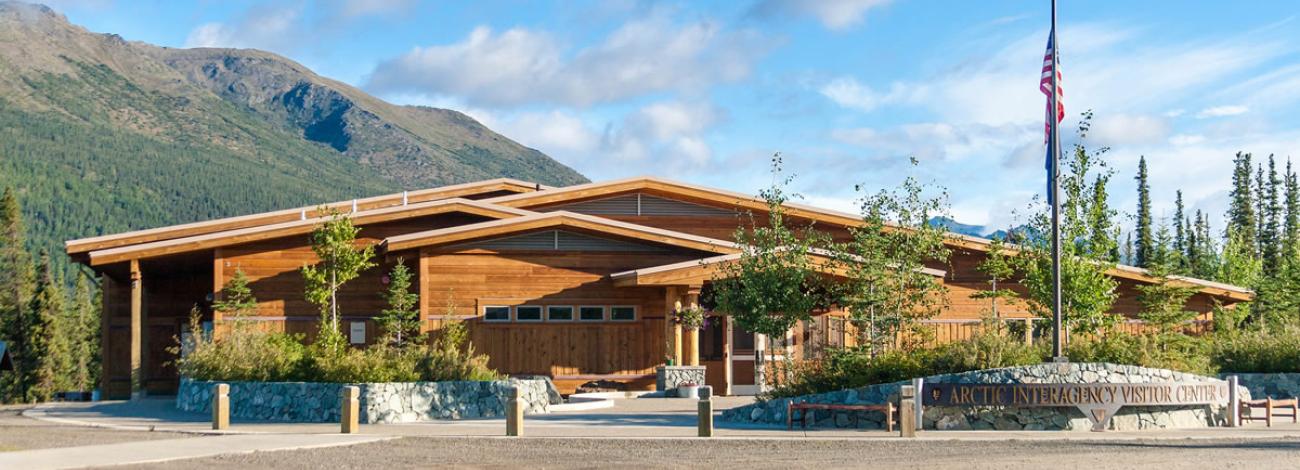
Arctic Interagency Visitor Center
Putting People in Touch with the Arctic
What is the Arctic Circle? How long did it take to build the trans-Alaska oil pipeline? What is a pingo and where can I see one? Find out at this award-winning visitor center located in Coldfoot, Alaska. Explore the exhibits, walk the nearby nature trails, or join an evening program to learn more about recreational opportunities along the Dalton Highway and the special landscapes and people of the far north.
About the Arctic Interagency Visitor Center
First opened in 2004, the Arctic Interagency Visitor Center is a partnership between three federal agencies that manage the public lands in northern Alaska: the Bureau of Land Management (the Dalton Highway Utility Corridor), the National Park Service (Gates of the Arctic National Park and Preserve), and the U.S. Fish and Wildlife Service (Arctic National Wildlife Refuge and Kanuti National Wildlife Refuge). The Alaska Geographic Association, our not-for-profit cooperating partner, operates a bookstore.
- Directions
Georeferenced PDF Maps
Dalton Highway - Fairbanks to Coldfoot (47 MB)
Dalton Highway - Coldfoot to Deadhorse (45 MB)
Getting to the Visitor Center
From Fairbanks, drive north 11 miles on the Steese Highway (AK-6) to its junction with the Elliott Highway (AK-2) in Fox. Follow the Elliott Highway 73 miles to the junction with the Dalton Highway (AK-11). Continue on the Dalton to Coldfoot at Milepost 175. (Read the Dalton Highway Visitor Guide).
It is about 260 miles from Fairbanks to Coldfoot, and the trip can take from 6 to 8 hours depending on weather, road conditions, and how often you stop along the way.
The visitor center entrance is on the west side of the highway (left as you head north) opposite the entrance to the cafe and truck stop. Coldfoot is not much more than a wide spot in the road. If you cross the bridge over Slate Creek, you’ve gone too far!
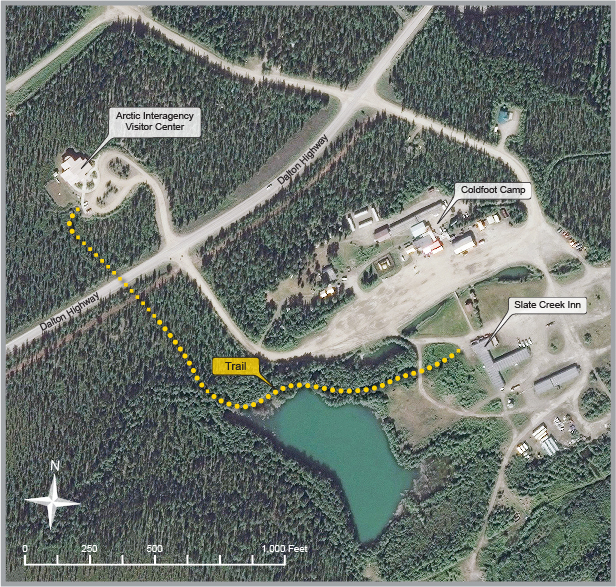
- Summer Hours
Summer hours: Open 12 p.m. - 9 p.m., late May through mid-September, including holidays.
Not visiting in the summer? The BLM Coldfoot Contact Station opened in late fall 2024. Learn more by reading about the Coldfoot Contact Station at the bottom of this page.
- Services
FREE ADMISSION
Exhibits and films
Interpretive presentations and programs
Walking trails
Trip planning assistance, maps, and brochures
Information on Dalton Highway road conditions, and facilities
Educational programs for groups (Arrange in advance)
Hunting and fishing information
Backcountry orientation and bear barrel loans
Backcountry registration for Gates of the Arctic National Park and Preserve
Alaska Geographic Association bookstore (AGA members receive a 15% discount)
- Interagency Partners
Arctic Alaska is arguably the largest, wildest region in the country. Natural processes reign, almost entirely unaltered by humans. Wild animals move freely across it. Rocks fall and rivers roar. It also contains an abundance and variety of crucial resources—minerals, metals, energy. Thousands of people call it home, and tens of thousands of people visit each year, to work, to recreate, and/or to marvel at the immensity of it all.
Some of the land is owned and managed by Alaska Native corporations and some of it is managed by the state of Alaska. But the vast majority is entrusted to three federal land management agencies: the National Park Service, the Fish and Wildlife Service, and the Bureau of Land Management. Each of these agencies manages different areas, under different mandates, and with different but complementary visions of sustainability.
Excerpt from Alaska Public Lands map. A large-scale map of Alaska showing all public lands, federal and state. Cartography by NPS, Harper's Ferry Center The National Park Service, whose mission is “to conserve the scenery and the natural and historic objects and the wild life therein and to provide for the enjoyment in such manner and by such means as will leave them unimpaired for the enjoyment of future generations”, is responsible for the 8.4 million acre Gates of the Arctic National Park and Preserve (visible to the west of the Dalton Highway through most of the Brooks Range), as well as the 6.6 million acre Noatak National Preserve, 1.8 million acre Kobuk Valley National Park, and 650,000 acre Cape Krusenstern National Monument, as well as the 2.7 million acre Bering Land Bridge National Park and Preserve south of the Arctic Circle. Parts of Gates of the Arctic and Noatak are protected as Wilderness—a designation that strives to keep places as natural and unaltered as possible. Unlike national parks elsewhere in the country, activities such as hunting and gathering are allowed in some areas, in recognition of the long heritage and continued reliance on subsistence in Alaska.
A hiker is a small speck in the vast landscape of Gates of the Arctic. NPS photo by Teri McMillan. The US Fish and Wildlife Service, whose mission is “to work with others to conserve, protect, and enhance fish, wildlife, and plants and their habitats for the continuing benefit of the American people”, is responsible for 3 National Wildlife Refuges in or near the Arctic: 1.6 million acre Kanuti (visible to the west of the Dalton south of the Brooks Range), 8.6 million acre Yukon Flats (east of the Dalton, from the White Mountains to the Brooks Range), and the 19.3 million acre Arctic (the huge swath of land east of the Dalton, through the Brooks Range and across the North Slope.) 8 million acres of the Arctic NWR are designated wilderness.
A caribou antler lies on the ground amid tundra wildflowers at Arctic National Wildlife Refuge. FWS photo by Lisa Hupp The Bureau of Land Management, whose mission is “to sustain the health, diversity, and productivity of public lands for the use and enjoyment of present and future generations”, is responsible for managing Arctic public lands in an approximately 2.1 million-acre corridor along 245 miles within the Dalton Highway corridor, and the approximately 23 million acre National Petroleum Reserve-Alaska (the largest single land unit in the U.S.) The BLM manages for its multiple-use mission that balances resource conservation to provide for fish and wildlife habitat, ecological integrity, and support of subsistence-based uses for rural communities; stewardship of cultural and paleontological resources; industrial resource development and use such as for locatable minerals and oil and gas resources; and a variety of recreational and educational opportunities including the Arctic Interagency Visitor Center in Coldfoot. Come visit!
A hiker looks down on the Dalton Highway and the trans-Alaska pipeline from the top of Sukakpak Mountain in the Brooks Range. BLM photo by Craig McCaa - Contact Us
Summer
Arctic Interagency Visitor Center
P.O. Box 9078
Coldfoot, AK 99709
Phone: 907-531-1224
Winter
Bureau of Land Management
222 University Avenue
Fairbanks, AK 99701
Phone: 907-474-2200 or toll-free 1-800-437-7021
TTY/Relay System: 711
Email: [email protected]- Coldfoot Contact Station for winter visitors
Are you planning a trip to Coldfoot after the Arctic Interagency Visitor Center is closed for the winter?
The Bureau of Land Management is opening the Coldfoot Contact Station for limited hours starting in the fall.
Park Rangers will be on hand to answer questions and give short interpretive programs. Visitors can also watch films, read books, and enjoy the warmth of the woodstove before heading out to enjoy the Arctic's snowy scenery and night sky dancing with aurora.
For more information contact the BLM's Fairbanks Public Room at 907-474-2200 or toll-free 1-800-437-7021
Coldfoot Contact Station The Coldfoot Contact Station is located on Coldfoot Road, east of the Dalton Highway. Coming from the south, take the second right off the Highway (across from Airport Road), pass the cell tower and turn left into the contact station's parking lot.
Image of Coldfoot, Alaska with the location of Coldfoot Contact Station marked in red.

